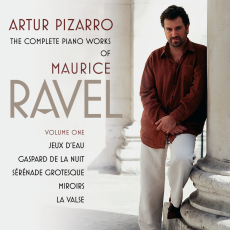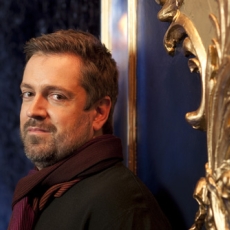Ravel - Pizarro - Audiophile Audition
Portuguese pianist Artur Pizarro performs the first installment of his projected Ravel cycle on the Hamburg Steinway D, recorded in the Teatro Sao Luiz, Lisbon, September 2006. A pupil of Sequeira Costa, and an auditor of Campos Coelho, Pizarro can trace his musical lineage back to Ricardo Vines, who had been privy to many of Ravel and Debussy's innermost thoughts. At all times, when listening to this marvelous recital, the pristine engineering by Julia Thomas induces one to think "shimmering" as an epithet to describe the pearly play suffusing these chiseled pieces.
New to the catalogue is Ravel's Serenade grotesque (1893), a percussive, Lisztian etude with Spanish colorations, a la Chabrier. The guitar figurations are marked pizzicatissimo, which Pizarro carries off quite effectively. Much of Ravel's piano music takes its cue from the water element, and Pizarro lavishes wonderful pedal effects to achieve the alternate tear and rain drop which the composer swirls together in pieces like Jeux d'eau and Ondine from the Gaspard suite. Une barque sur l'ocean has the piano imitating harp and celesta at once, Even more rife in the Ravel canon are sounds of bells, and the difference between water and bells (repeated notes) may become moot. The virtuosic seguidilla Alborada del gracioso bounces and boomerangs with touches of light, imagistically reflected off guitar frets. Pizarro keeps a suave handle of this explosive music, a pianistic flash of kaleidoscopic colors. Le Gibet from the Gaspard suite is a bell of a macabre order, direct from the group of those described by Poe. The Valley of Bells remains Ravel's lyrical homage to the churches of Paris, though many of its passing harmonies provide fodder for Rachmaninov.
Pizarro's tour de force, beyond the punishing Gaspard de la Nuit, is the solo edition of La Valse (1920), which I first heard via Leonard Pennario. A grumblingly busy left hand underpins the Viennese figures‚ inchoate liltings at the onset of this wonderfully transparent, albeit misty, invocation of 19th Century charm. Block chords and wicked glissandi alternate with the undulations of the ghostly dancers, adding colors and thick stretti as we progress towards the ultimate collapse of the dance, of the epoch that bore the mantle of cultivated, waltzing sexuality. A vivid recording of vibrant music, this disc.

